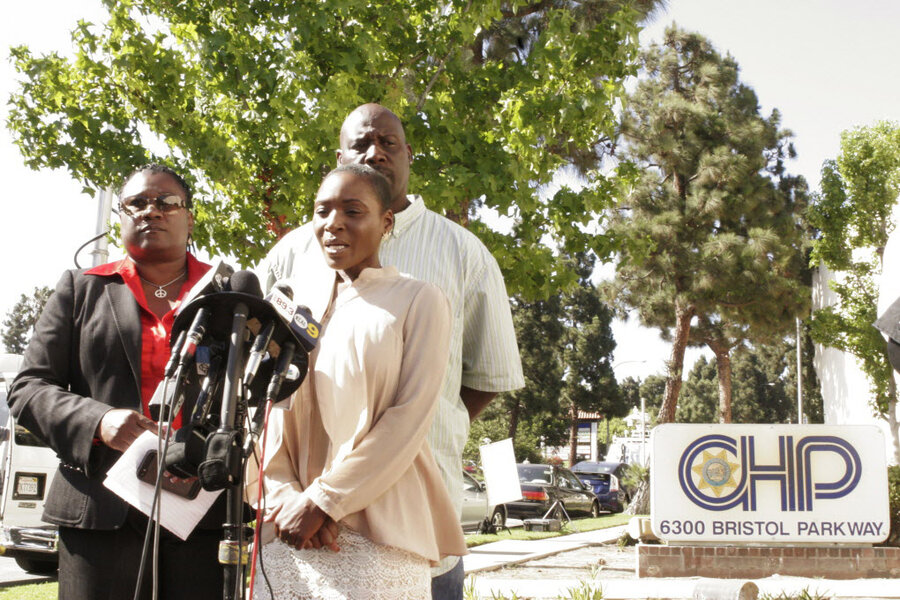Videotaped beating of woman in L.A.: Is it Rodney King all over again?
| Los Angeles
The videotaped beating of a homeless and barefoot African-American woman by one California Highway Patrol officer is reopening the race-relations dialogue – at times soul-searching, at times bitter – initiated here by the videotaped beating of motorist Rodney King 23 years ago.
Community activists, police watchdog groups, and national analysts are trying to assess the similarities and differences between the beating of the woman on the side of a major Los Angeles freeway, the I-10, on July 1, and the beating of Mr. King after a high-speed car chase on March 3, 1991. The acquittal of four white police officers in the King case led to the 1992 Los Angeles riots, the costliest in US history with more than 50 people killed and 2,000 injured.
The comparison of the two incidents has provided ample insight into how far the issue of police brutality has, or has not, progressed, analysts say.
Recorded on the cellphone of a passerby, the video shows a light-skinned California Highway Patrol (CHP) officer – who remains unnamed – repeatedly punching a woman in the face on the side of the freeway.
Earlier in the video the woman is seen walking along the freeway when the CHP officer catches up to her and tries to keep her from walking into traffic. A third figure appears in the video, later reported to be an officer in plain clothes.
The CHP version of events is that the first officer tried to stop the woman, but that she repeatedly ignored the commands, at one point veering “into the traffic lanes.”
“During the conversation the pedestrian then becomes physically combative, at which point the officer is forced to place the pedestrian under arrest in fear of the pedestrian's and officer's safety," the CHP report said. "A physical altercation ensued as the pedestrian continued to resist arrest."
But Earl Ofari Hutchinson, a local activist and author of several books on the black image in America, takes a decidedly different view, saying this latest beating has provoked the same anger and rage from community residents as the King beating, and sparked demands for federal and state probes, and prosecution of the officer or officers.
"It's no exaggeration to say this is a Rodney King II case. The parallels are obvious,” he says. “Two police officers physically assaulting a woman, the woman is African-American, and the assault is captured by a passing civilian with his camera in all its graphic, gory, and shocking detail.”
But Najee Ali, a local activist who has been leading protests against the LAPD since the King incident, says community/police relations have come a long way since then, owing to cultural training of police and the advance of community policing.
The CHP beating is completely out of keeping with standard behavior of the agency, he adds, and therefore shows that “there are still rogue cops out there that can give an agency a black eye.”
Some analysts say the larger story is the increase of such incidents nationally, including an Arizona State University professor who was roughed up and arrested on video by campus police in May.
“Apparently, not much has been learned since Rodney King,” says Randolph McClaughlin, a law professor at Pace Law School in White Plains, N.Y., noting that three police brutality cases have been logged in New York alone in the past three years.
“This is really on the increase, not just in California or the South, or New York,” he says. “You would think that the proliferation of people with video capabilities on their phone would be a deterrent, but I think the problem is the police keep being given the benefit of the doubt by the justice system that works with them day in and out.”
Lester Spence, an associate professor in the political science department at Johns Hopkins Universty in Baltimore, sees the proliferation of cellphone cameras differently, saying so many such incidents have gone viral that viewers are desensitized.
“There is a numbing effect when you see so many of these online, on the news and people’s Facebook pages,” he says.
Whether the July 1 beating results in a trial, or what the outcome of the trial would be, remains to be seen.
New York-based attorney Alan Futerfas, who has more than 25 years' experience in criminal defense, says he finds the portion of the video after the woman is tackled to be disturbing, because the woman is not seen resisting in any way. But he notes that it’s important to remember that key portions of what happened – which might play into jury findings in the future – cannot be heard.
“People can have an immediate emotional reaction to what they see on the tape,” says Mr. Futerfas. “But we don’t know what was said by the woman, or what the officer said back, or if the woman was mentally disturbed or on drugs.”
Whatever the legal outcome of this incident, the images are leaving their mark on the Los Angeles community.
Jasmyne Cannick, an African-American media and social commentator who blogs about politics, says the incident needs to be seen in the context of a growing number of police abuse cases that she says stem from officers who somehow “are able to pass the psychological test to become a sworn officer in the first place.”
She mentions the recent case of LAPD Det. Frank Lyga, who is accused of making racially charged comments about shooting black men, and is being sued by an LAPD captain who claims Lyga made vulgar comments about her in front of dozens of their colleagues. Another is the case of the son of a retired LAPD officer who was merely suspended for uttering a racial slur.
“They all have serious issues with race but somehow that went undetected by their agencies,” says Ms. Cannick.
The CHP says it is investigating and will have a report within two weeks.





